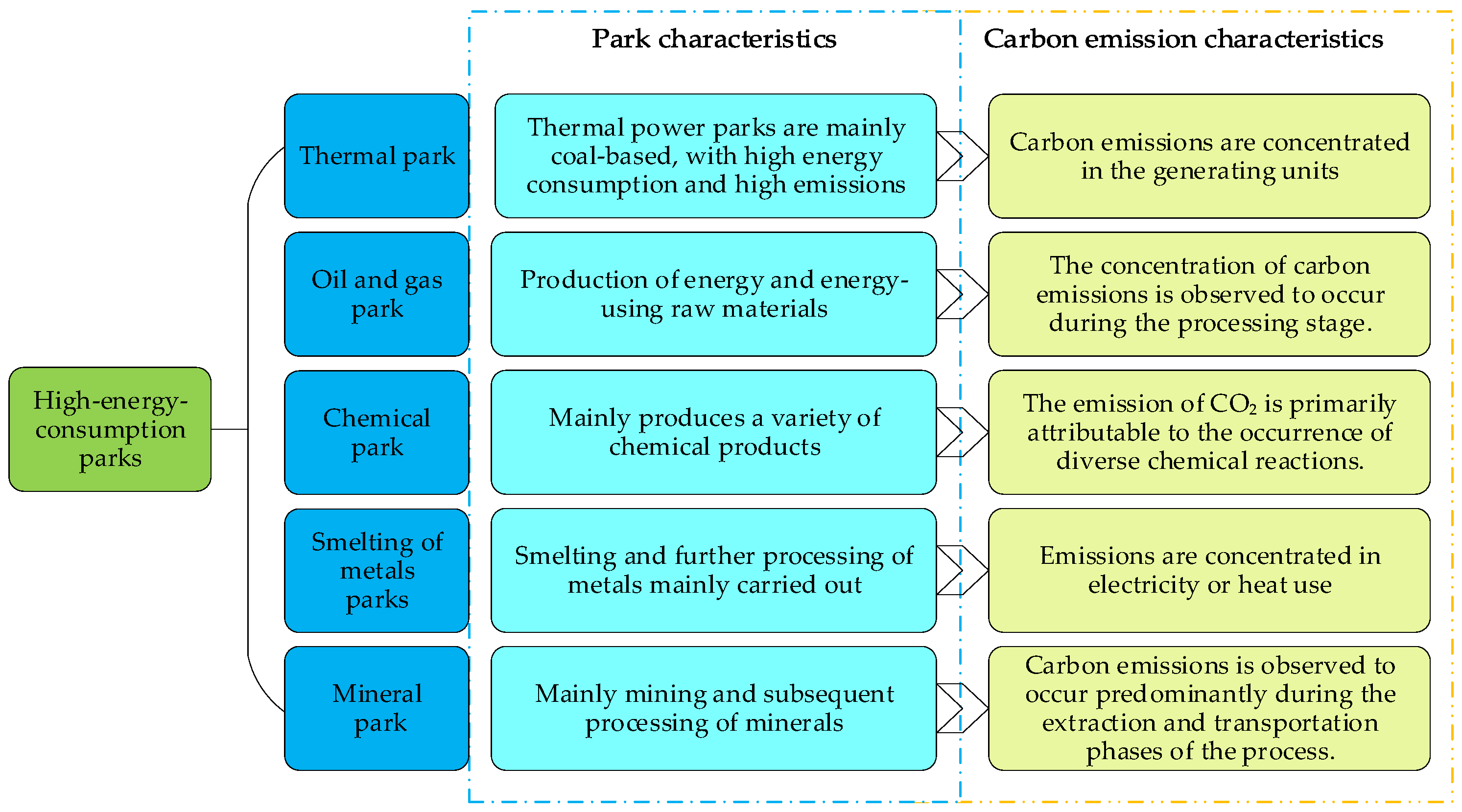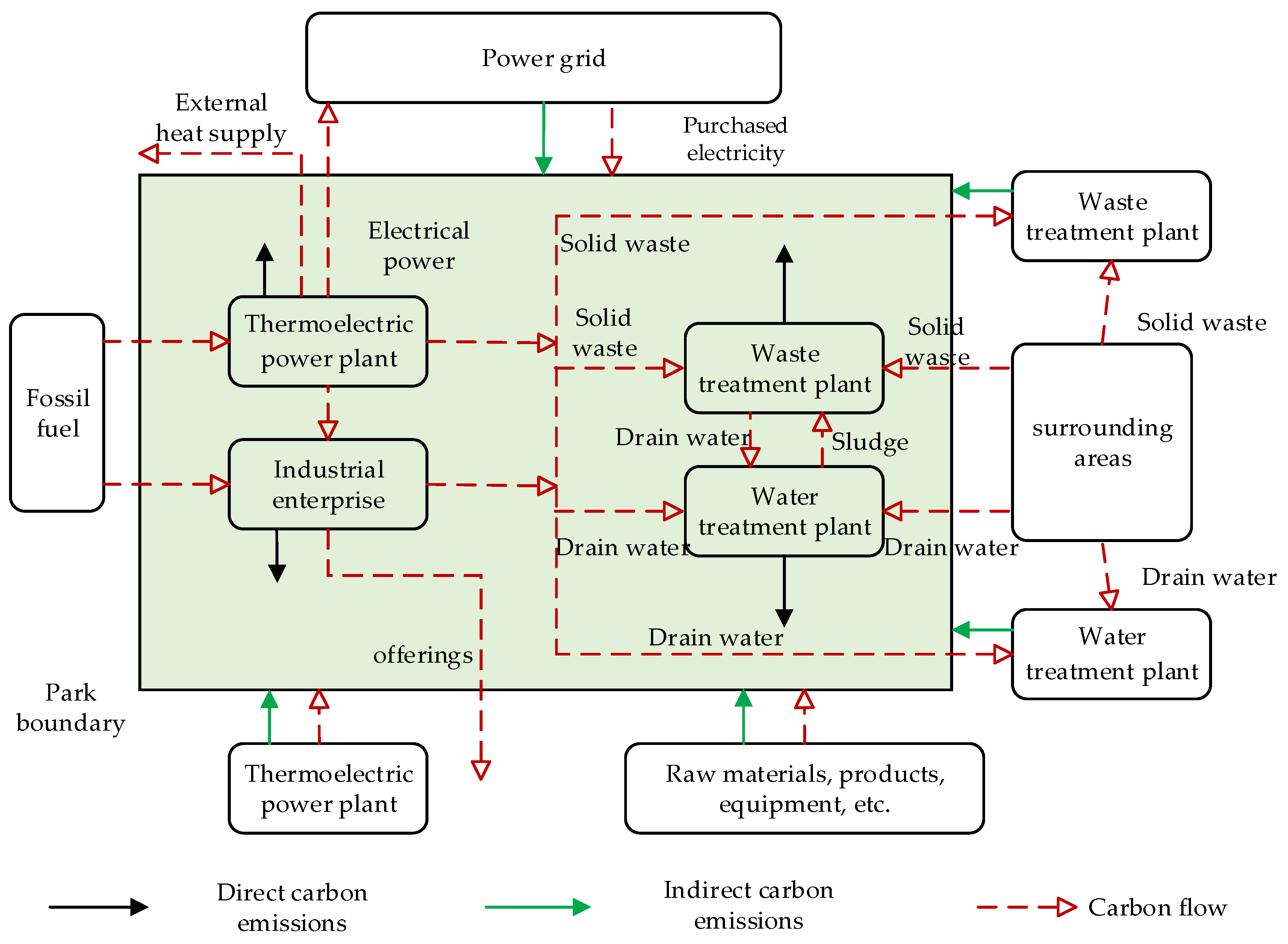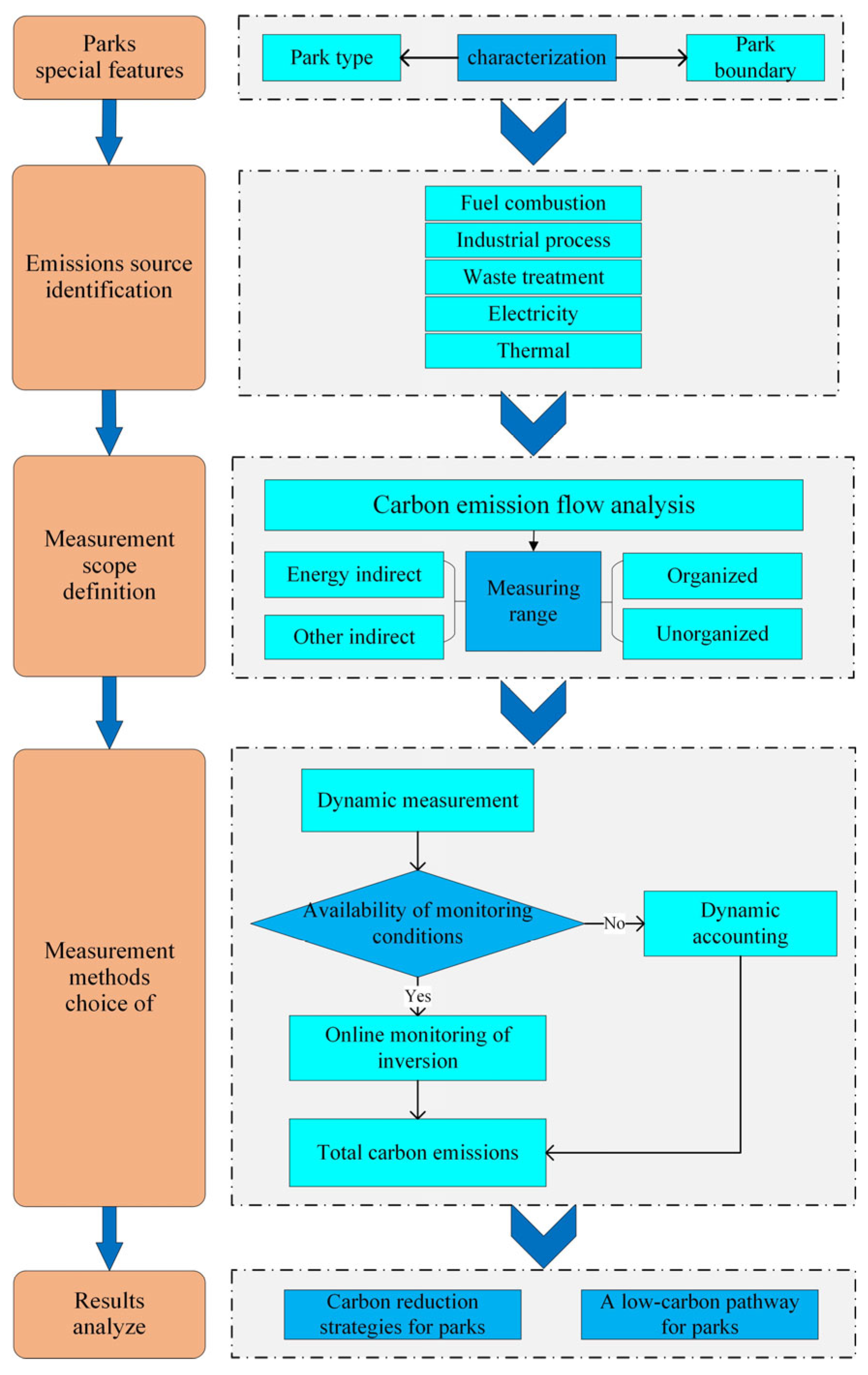Overview of Carbon Emission Source Analysis and Measurement Methods in Energy-Consuming Parks
Abstract
1. Introduction
- Real-time emission source identification;
- Cross-sectoral carbon flow mapping;
- Data-driven compliance verification [2].
2. Characteristics of Energy-Consuming Parks
2.1. Types of Energy-Consuming Parks
2.2. Boundary Demarcation of Energy-Consuming Parks
3. Carbon Emission Source Analysis in Energy-Consuming Parks
3.1. Scoping of Carbon Emissions Measurement
3.2. Analysis of Emission Sources in Five Typical Parks
3.2.1. Thermal Parks
3.2.2. Oil and Gas Parks
3.2.3. Chemical Parks
- (1)
- Carbon in chemical compounds: Carbon is ubiquitous in chemical compounds, as most chemical reactions involve the transformation of functional groups, such as carbon–carbon bonds. The portion of carbon that does not integrate into the final product may form byproducts or waste. Consequently, carbon emission management in chemical parks is a dynamic process, heavily dependent on the specific product being manufactured and its structural characteristics.
- (2)
- Carbon in fuels: Carbon present in fuels, particularly those derived from fossil energy sources, typically undergoes chemical reactions (e.g., oxidation) that convert the chemical energy stored in these fuels into thermal energy. During this process, carbon is oxidized to carbon dioxide, which is considered the “unchanged component” in carbon emission management within chemical parks. Once fuel combustion infrastructure is operational, its processes and efficiencies become relatively fixed, leading to a direct correlation between carbon emissions and fuel consumption.
- (3)
- Life cycle carbon emissions: From a comprehensive life cycle perspective, the production, processing, and transportation of chemical raw materials and energy sources inevitably generate carbon emissions. These emissions constitute the carbon footprint of the raw materials and energy consumed within the park. For carbon categories I and II, the system boundary is confined to the park itself. However, for category III, particularly in the case of electricity and heat, it is necessary to account for upstream carbon emissions generated during their production processes.
3.2.4. Metal Smelting Parks
3.2.5. Non-Metallic Mineral Product Parks
3.2.6. Scope of Measurement of Park Emission Sources
3.3. Carbon Emission Flow Analysis
3.4. Generic Park Emission Sources and Scope of Measurement
- (1)
- Fossil fuel combustion emissions
- (2)
- Industrial process emissions
- (3)
- Waste treatment emissions
- (4)
- Carbon emissions from electricity consumption
- (5)
- Carbon emissions from heat use
3.5. Definition of Carbon Accounting Gas Categories
4. A Study on the Measurement of Carbon in Energy-Consuming Parks
4.1. Direct Carbon Emissions
- (1)
- Organized carbon emissions
- (2)
- Unorganized carbon emissions
4.2. Indirect Carbon Emissions
4.3. Park Carbon Measurement Process
5. Discussion
- (1)
- Accurate determination of emission factors (EFs) is critical for reliable carbon quantification. Traditional approaches that treat entire industrial parks as homogeneous entities for EF calculation require refinement. Instead, it is imperative to establish differentiated EF models that dynamically adapt to park typologies (e.g., chemical, metallurgical), industrial processes, and geographic-specific emission profiles. A granular framework should be implemented to calculate EFs at the subsystem level, distinguishing between individual equipment units and specific production processes, thereby mitigating errors inherent in conventional average-based EF allocation. Continuous refinement and granular optimization of EF determination methodologies will significantly enhance data comparability and accuracy. This approach aligns with the operational realities of industrial ecosystems, where emission intensities vary substantially across production stages. Advanced data disaggregation techniques, combined with machine learning-enabled dynamic EF calibration, can further improve model adaptability to fluctuating operational conditions and technological upgrades.
- (2)
- While continuous emission monitoring systems (CEMSs) for organized carbon emissions have achieved operational maturity, persistent technical limitations require targeted resolution. Key challenges include accuracy–complexity trade-off: Current systems exhibit compromised data reliability (typical uncertainty >15%) due to sensor drift, while their integration with legacy CEMSs necessitates costly secondary development (average 35% project cost overrun); and environmental resilience deficits: prolonged exposure to extreme conditions (e.g., >300 °C flue gas, 90% RH humidity) accelerates sensor degradation, with field studies showing a 23% performance decline within 6 months under such stressors.
- (3)
- Fugitive carbon emissions exhibit characteristics of multiple dispersed sources, variable locations, fluctuating emission volumes, and significant terrain influence, substantially complicating monitoring efforts. Prolonged field deployment of monitoring equipment coupled with frequent power source replacements introduces substantial human interference, necessitating robust electrical infrastructure to ensure data reliability. While satellite remote sensing can estimate regional carbon fluxes, its limited spatiotemporal resolution impedes precise source attribution of fugitive emissions. Acquiring high-precision measurement data to strengthen emission inversion modeling constitutes a pivotal research frontier [41].
- (4)
- Measurement constraints arise from data gaps in supply chain aspects and reliance on average grid factors, compromising measurement accuracy and amplifying data uncertainty. Sensor performance demonstrates monthly accuracy degradation of 3–5%, while cross-sensitivity to non-target gases (e.g., methane) introduces measurement inaccuracies. Inadequate deployment of edge computing devices in remote mining areas results in data latency exceeding two hours.
- (5)
- Deployment of monitoring technologies in industrial parks faces significant challenges, as high-precision systems carry prohibitively high costs that hinder adoption in developing economies. Internationally, the absence of standardized protocols creates implementation barriers for enterprises seeking to adopt these technologies. Data silos across industries further compound these operational challenges. Traditional manufacturing sectors exhibit strong resistance to carbon accounting practices.
- (6)
- During the “14th Five-Year Plan” period, high-energy-consuming parks will be fully integrated into the carbon-trading market. The monitoring, reporting, and verification of greenhouse gases constitutes the foundation for the smooth operation of carbon emissions trading. The key objective of monitoring, reporting, and verification system construction is to obtain high-quality carbon emission monitoring data. The improvement of the quality of carbon emission monitoring data and the establishment of data uncertainty analysis methods are also urgent issues that require resolution.
6. Conclusions
Author Contributions
Funding
Data Availability Statement
Acknowledgments
Conflicts of Interest
References
- Liu, X.Z.; Sun, X.; Zhu, Q.K.; Shang, Y.T. Review on the Measurement Methods of Carbon Dioxide Emissions in China. Ecol. Econ. 2017, 33, 21–27. [Google Scholar]
- Chen, W.H.; Lu, X. The optimal layout of CCUS clusters in China’s coal-fired power plants towards carbon neutrality. Clim. Change Res. 2022, 18, 261–271. [Google Scholar]
- Liu, L.; Zhang, B.; Bi, J.; Wei, Q.; He, P. The greenhouse gas mitigation of industrial parks in China: A case study of Suzhou industrial park. Energy Policy 2012, 46, 301–307. [Google Scholar] [CrossRef]
- Wang, H.; Lei, Y.; Wang, H.; Liu, M.; Yang, J.; Bi, J. Carbon reduction potentials of China’s industrial parks: A case study of Suzhou industry park. Energy 2013, 55, 668–675. [Google Scholar] [CrossRef]
- Liu, W.; Tian, J.; Chen, L. Greenhouse gas emissions in China’s eco-industrial parks: A case study of the Beijing economic technological development area. J. Clean. Prod. 2014, 66, 384–391. [Google Scholar] [CrossRef]
- Wang, N.; Guo, Z.; Meng, F. The circular economy and carbon footprint: A systematic accounting for typical coal-fuelled power industrial parks. J. Clean. Prod. 2019, 229, 1262–1273. [Google Scholar] [CrossRef]
- Yu, X.; Zheng, H.; Sun, L. An emissions accounting framework for industrial parks in China. J. Clean. Prod. 2019, 244, 118712. [Google Scholar] [CrossRef]
- Yan, K.; Lv, Y.; Guo, Y. Review on Greenhouse Gas Accounting Methods on China’s Industrial Parks. Chin. J. Environ. Manag. 2021, 13, 13–23. [Google Scholar] [CrossRef]
- Hu, B.; Sun, K.B.; Shao, C.Z.; Huang, W.; Zhao, Y.S.; Xie, K.G. Carbon awareness and optimization methods for park-level integrated energy systems considering whole-process carbon footprint. High Volt. Eng. 2022, 48, 2495–2504. [Google Scholar]
- Ji, L.; Liang, S.; Qu, S. Greenhouse gas emission factors of purchased electricity from interconnected grids. Appl. Energy 2016, 184, 751–758. [Google Scholar] [CrossRef]
- Zhang, N.; Li, Y.; Huang, J. Carbon Measurement Method and Carbon Meter System for Whole Chain of Power System. Autom. Electr. Power Syst. 2023, 47, 2–12. [Google Scholar] [CrossRef]
- Qi, J.; Chen, B. Greenhouse Gas Emission Inventory of Industrial Parks. Acta Ecol. Sin. 2015, 35, 2750–2760. [Google Scholar]
- Wang, J.; Wang, Y.; Zhou, M. Accounting Method of Users’ Indirect Carbon Emissions Considering Green Electricity Trading. Power Syst. Technol. 2024, 48, 29–38. [Google Scholar] [CrossRef]
- Cheng, Y.; Zhang, N.; Wang, Y. Modeling carbon emission flow in multiple energy systems. IEEE Trans. Smart Grid 2019, 10, 3562–3574. [Google Scholar] [CrossRef]
- Lyu, Y.; Gao, H.; Yan, K.; Liu, Y.; Tian, J.; Chen, L.; Wan, M. Carbon peaking strategies for industrial parks: Model development and applications in China. Appl. Energy 2022, 322, 119442. [Google Scholar]
- Wei, X.; Qiu, R.; Liang, Y.; Liao, Q.; Klemeš, J.J.; Xue, J.; Zhang, H. Roadmap to carbon emissions neutral industrial parks: Energy, economic and environmental analysis. Energy 2022, 238, 121732. [Google Scholar]
- Wu, Q.; Tu, K.; Zeng, Y. Research on China’s energy strategic situation under the carbon peaking and carbon neutrality goals. Chin. Sci. Bull. 2023, 68, 1884–1898. [Google Scholar]
- Tan, Q.; Zhao, H. Carbon Emission Factors and Decoupling Effects of China’s Power Industry under the Background of Carbon Peak. Electr. Power 2024, 57, 88–98. [Google Scholar]
- Zhou, Y.B.; Zhang, S.N.; Hou, F.X.; Ren, H.T.; Xun, P.F. Analysis of Carbon Peaking in Power Sector and its Impact on Promoting Whole-Society Carbon Emissions Reduction. Electr. Power 2024, 57, 1–9. [Google Scholar]
- Wang, Y.X.; Yu, Z.; Huang, H.Q.; Li, S.W.; Dong, M.Q.; Wang, P.F.; Wang, D. Spatial-temporal evolution and driving factors analysis of carbon emissions in China’s thermal power industry. Environ. Pollut. Control 2024, 46, 1662–1668+1678. [Google Scholar]
- Wang, S.; Zhou, B.; Qu, J.B.; Li, J.H.; Yi, L.Z.; Wu, X.; Yang, Y.; Xu, X.; Bo, X. Air pollution impact of thermal power industry in Shandong Province under carbon peak and carbon neutrality scenario. China Environ. Sci. 2024, 44, 5990–5998. [Google Scholar]
- Dou, L.; Gao, F.; Peng, Y.; Wang, X.; Xiong, L. Green transition situations and development suggestions for upstream petroleum industry. Bull. Chin. Acad. Sci. 2024, 39, 1205–1216. [Google Scholar]
- Wang, T.; Li, G.; Song, X.; Wang, H.; Wang, G.; Liu, Z. Development of Smart Oil and Gas Fields with Multi-energy Synergy of Wind, Solar, Geothermal, and Energy Storage. Strateg. Study CAE 2024, 26, 259–270. [Google Scholar]
- Zheng, S.L.; Ye, S.F.; Wang, Q.; Ma, S.H.; Wang, Z.; Sun, Z.; Qiao, S.; Zhang, X.M.; Zhang, Y. Analysis and thinking of low-carbon technology in non-ferrous metal industry. Chin. J. Process Eng. 2022, 22, 1333–1348. [Google Scholar]
- Gu Lin, H.K.; Ma, M. Research on low carbon development of non-ferrous metallurgical industry in terms of energy structure. China Nonferrous Metall. 2022, 51, 1–7. [Google Scholar]
- Liu, L.; Lei, Y.; Zhi, S.; Chen, W.; Chai, C.; Shao, Z.; Liu, Z.; Liu, C. Potential and Optimization Deployment of CCUS Technology Emission Reduction at Point Source Level in China’s Cement Industry. J. Beijing Inst. Technol. (Soc. Sci. Ed.) 2024, 26, 56–67. [Google Scholar]
- Ma, M.; Huang, Z.; Wang, J.; Niu, L.; Zhang, W.; Xu, X.; Xi, F.; Liu, Z. Carbon uptake by cement in China: Estimation and contribution to carbon neutrality goals. Sci. Sin. Terrae 2024, 54, 2086–2097. [Google Scholar]
- Wang, P.; Zhao, Y.; Zhang, J.; Xiong, Z. Research progress on carbon measurement methods of coal-fired power plants under the background of carbon neutrality. Clean Coal Technol. 2022, 28, 170–183. [Google Scholar]
- Xie, J.; Guo, J.; Huang, Y.; Liu, W.; Xu, M. Accounting for household carbon emissions and estimating their proportion in China based on multi-source data. Chin. J. Environ. Eng. 2024, 18, 3081–3091. [Google Scholar]
- Li, Y.W.; Yang, X.X.; Liu, C. A review on carbon emission accounting approaches for the electricity power industry. Appl. Energy 2024, 359, 122681. [Google Scholar]
- Liu, Z.X.; Xu, Z.Y.; Zheng, W.F. Calculation of carbon emissions in wastewater treatment and its neutralization measures: A review. Sci. Total. Environ. 2024, 912, 169356. [Google Scholar] [CrossRef] [PubMed]
- Zhang, H.X.; Sun, W.Q.; Ma, G.Y. A carbon flow tracing and carbon accounting method for exploring CO2 emissions of the iron and steel industry: An integrated material-energy-carbon hub. Appl. Energy 2022, 309, 118485. [Google Scholar]
- Paul, K.I.; Roxburgh, S.H. A national accounting framework for fire and carbon dynamics in Australian savannas. Int. J. Wildland Fire 2024, 33, WF23104. [Google Scholar] [CrossRef]
- Li, L.Q.; Wang, X.H.; Ren, N.Q. Carbon neutrality of wastewater treatment-A systematic concept beyond the plant boundary. Environ. Sci. Ecotechnology 2022, 11, 100180. [Google Scholar] [CrossRef]
- Ma, Y.; Chen, Y.; Wei, Y.; Li, Q.; Liu, X.; Zhang, A. Carbon Flow Tracking based Carbon Emission Accounting of Low-Carbon Industrial Parks. In Proceedings of the 2022 IEEE 6th Conference on Energy Internet and Energy System Integration (EI2), Chengdu, China, 11–13 November 2022. [Google Scholar]
- Raza, S.; Ghasali, E.; Erk, N. Advances in technology and utilization of natural resources for achieving carbon neutrality and a sustainable solution to neutral environment. Environ. Res. 2023, 220, 115135. [Google Scholar] [CrossRef]
- Li, Y.; Brando, P.M.; Randerson, J.T. Deforestation-induced climate change reduces carbon storage in remaining tropical forests. Nat. Commun. 2022, 13, 1964. [Google Scholar]
- Chen, B.; Yang, W.S. Beijing Normal University State Key Joint Laboratory of Environmental Simulation and Pollution Control/School of Environment. Carbon emission accounting methods for industrial parks. China Popul. Resour. Environ. 2017, 27, 1–10. [Google Scholar]
- Cai, B.F.; Zhu, S.L.; Yu, S.M.; Dong, H.M.; Zhang, C.Y.; Wang, C.K.; Zhu, J.H.; Gao, Q.X.; Fang, S.X.; Pan, X.B.; et al. The Interpretation of 2019 Refinement to the 2006 IPCC Guidelines for National Greenhouse Gas Inventory. Environ. Eng. 2019, 37, 1–11. [Google Scholar]
- Wu, X.P.; Kang, C.Q.; Yuan, Q.H. A Review of the Impact Factors of Carbon Emissions and the Accounting Methods for Electricity Carbon Emissions in China. Proc. CSEE 2024, 44 (Suppl. S1), 1–18. [Google Scholar]
- Hua, J.C.; Zeng, Z.C. Quantifying the scattering effect of dust aerosols on satellite remote sensing retrievals of atmospheric carbon dioxide. Natl. Remote Sens. Bull. 2024, 28, 2582–2599. [Google Scholar] [CrossRef]











| Greenhouse Gas Sources | Fuel Combustion | Fuel Supply Chain | Desulfurization and Denitrification | Vaporization |
|---|---|---|---|---|
| Share of carbon emissions | 80~95% | 5~15% | 1~3% | 0.5~2% |
| (a) | |||
| Greenhouse gas sources | Extraction and drilling | Fugitive gas | Fossil fuel combustion |
| Share of carbon emissions | 10% | 14% | 33% |
| (b) | |||
| Greenhouse gas sources | Crude oil transport (ships) | Crude oil transport (pipeline) | Refinery heat and power systems |
| Share of carbon emissions | 3% | 2% | 38% |
| Classification of Carbon Emission Sources | Gas Type |
|---|---|
| Fossil fuel combustion emissions | CO2 |
| Industrial process emissions | The presence of CO2 and other non-CO2 gases |
| Waste treatment emissions | CO2, CH4, N2O |
| Carbon emissions from electricity | CO2 |
| Carbon emissions from heat | CO2 |
| Form | Advantage | Drawbacks | Applicable Objects | Application Status |
|---|---|---|---|---|
| emission factor approach |
| poor timeliness | Emission sources change more steadily, ignoring complexity within the system |
|
| method of actual measurement |
|
| Sites with access to first-hand measured data |
|
| Methodologies | Sources of Uncertainty | Calibration Method | Data Reliability | Applicable Scenarios |
|---|---|---|---|---|
| emission factor approach | activity data errors, emission factors not updated | regularly synchronized with the Industry Factors database | low | applicable to industries conducting preliminary carbon accounting |
| method of actual measurement | infrared instruments drift over time, temperature, humidity | uses standard gas for range and zero calibration | high | suitable for industries requiring audited data |
| dynamic measurement method | sensor signal-to-noise ratio issues | distributed Sensor Time Alignment | center | for industries with variable processes |
| electro–carbon method | regional grid changes, carbon intensity over time | calibration using real-time data | center | industries with high electricity consumption |
| Methodologies | Cost | Precision | Spatial Scale | Time Scale | Applicable Scenarios |
|---|---|---|---|---|---|
| satellite remote sensing | high | center | global coverage | day | regional-level monitoring |
| ground sensor networks | center | high | small-scale | real time | campus monitoring |
| traditional accounting | low | large error | enterprise-class | monthly or annual | emission estimates |
| AI predictive modeling | center | related to data quality | high | near real time | carbon intensity projections |
Disclaimer/Publisher’s Note: The statements, opinions and data contained in all publications are solely those of the individual author(s) and contributor(s) and not of MDPI and/or the editor(s). MDPI and/or the editor(s) disclaim responsibility for any injury to people or property resulting from any ideas, methods, instructions or products referred to in the content. |
© 2025 by the authors. Licensee MDPI, Basel, Switzerland. This article is an open access article distributed under the terms and conditions of the Creative Commons Attribution (CC BY) license (https://creativecommons.org/licenses/by/4.0/).
Share and Cite
Wei, Y.; Chang, Z.; Zhang, Y.; Liu, X.; Cheng, Y.; Zhang, J.; Pang, B.; Liu, Z.; Li, Q. Overview of Carbon Emission Source Analysis and Measurement Methods in Energy-Consuming Parks. Processes 2025, 13, 989. https://doi.org/10.3390/pr13040989
Wei Y, Chang Z, Zhang Y, Liu X, Cheng Y, Zhang J, Pang B, Liu Z, Li Q. Overview of Carbon Emission Source Analysis and Measurement Methods in Energy-Consuming Parks. Processes. 2025; 13(4):989. https://doi.org/10.3390/pr13040989
Chicago/Turabian StyleWei, Yang, Zhenwei Chang, Yibin Zhang, Xueyuan Liu, Yumin Cheng, Jie Zhang, Bo Pang, Zhenyang Liu, and Qian Li. 2025. "Overview of Carbon Emission Source Analysis and Measurement Methods in Energy-Consuming Parks" Processes 13, no. 4: 989. https://doi.org/10.3390/pr13040989
APA StyleWei, Y., Chang, Z., Zhang, Y., Liu, X., Cheng, Y., Zhang, J., Pang, B., Liu, Z., & Li, Q. (2025). Overview of Carbon Emission Source Analysis and Measurement Methods in Energy-Consuming Parks. Processes, 13(4), 989. https://doi.org/10.3390/pr13040989





